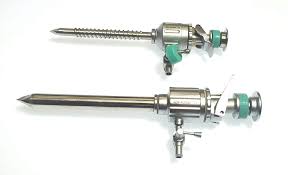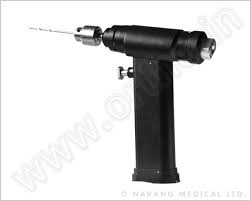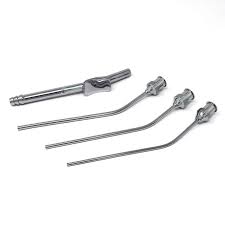A Laparoscopic Trocar is an essential surgical instrument used in minimally invasive procedures, particularly in laparoscopy. It serves as a gateway for introducing other surgical tools such as cameras, scissors, graspers, and dissectors into the abdominal cavity without making large incisions. The trocar plays a vital role in maintaining the sterile barrier and preserving the integrity of the insufflated (gas-filled) abdominal environment during surgery.
A typical laparoscopic trocar comprises three main components: the cannula (hollow tube), the obturator (a pointed or blunt introducer), and often a seal mechanism to prevent gas leakage. The surgeon first inserts the trocar through a small incision, using the obturator to pierce the abdominal wall. Once inside, the obturator is removed, leaving the cannula in place as a stable port for laparoscopic instruments.
Trocars are available in various sizes, generally ranging from 5mm to 15mm in diameter, depending on the nature and requirements of the surgery. They may be bladed, bladeless, or optical, with each type designed to minimize trauma to the tissue. Optical trocars include a transparent obturator tip that accommodates a laparoscope, allowing the surgeon to visualize the tissue layers during entry and reduce the risk of internal injury.
Some advanced trocars feature safety shields or dilating tips to enhance patient safety. They may also be equipped with valve systems to prevent insufflation gas from escaping when instruments are inserted or removed. The use of disposable or single-use trocars is common in many surgical settings to ensure sterility and reduce the risk of cross-contamination. However, reusable trocars are also available and preferred in certain hospitals for cost-efficiency and sustainability.
Laparoscopic trocars are used in a wide range of procedures, including appendectomies, cholecystectomies, hernia repairs, hysterectomies, bariatric surgeries, and urological operations. Their design continues to evolve, with innovations focusing on ergonomic grip, reduced insertion force, enhanced sealing mechanisms, and minimized tissue trauma.
In summary, the laparoscopic trocar is a fundamental tool in the field of minimally invasive surgery. Its design allows for safe, efficient, and repeated instrument access to the abdominal cavity while maintaining pneumoperitoneum. With ongoing advancements in material science and engineering, modern trocars offer enhanced performance, greater safety, and better outcomes for both surgeons and patients.







Reviews
There are no reviews yet.